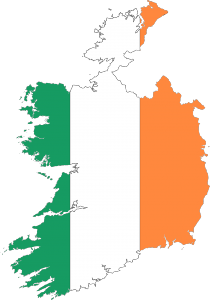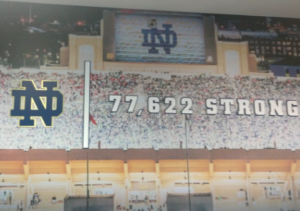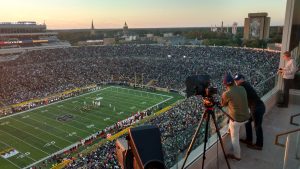Notre Dame Athletic Director and Vice President Jack Swarbrick remains optimistic that his college football program will play a full schedule this fall. Even if we see college football move to a “conference only” model, which has been proposed, he still feels good about the independent Fighting Irish playing a full slate.
However, Swarbrick admits that it’s going to be a bigger challenge for college sports to restart all at the same time than it is for professional leagues. The coronavirus pandemic has hit different cities, states and regions with differing severity, so there’s no one size fits all approach to re-opening.
Notre Dame A.D. Jack Swarbrick asked about advantages/disadvanatages that might arise with some states opening up before others: “great disparity will be inevitable” when/as college sports returns.
Admits easier time for pro sports to open up all at the same time— Paul M. Banks (he/him) (@PaulMBanks) May 5, 2020
The ND VP realizes that as different states re-open in different phases, on different timelines, “a great disparity will be inevitable” in college football.
“Imagine, for example — and this is purely hypothetical on my part — that campus chooses to open with the start of fall term,” Swarbrick said in a Zoom call with the media today.
Media Zoom call with Notre Dame A.D. Jack Swarbrick some takeaways
-Navy game still on, for now
-admits college sports will have more issues re-opening than pros
-tailgating presents 1 of the biggest challenges among the many facets of gamedays
-May 15 still big decision date— Paul M. Banks (he/him) (@PaulMBanks) May 5, 2020
“And that’s the first date the residence halls are open. Well we’ve all agreed that six and, more likely seven, weeks will be required to safely prepare the football team. So in the interest of safety, as with the decision to open the dorms, you’d have to figure out a way to assemble those students, to put them in an environment that’s safe, whether it’s a residence hall or you make other accommodations to feed them and to prepare them for the season.”
“In that regard, fall sports teams collecting for the purposes of preparing may in fact happen before schools are fully open at a number of places.”
As of now, the Navy game in Dublin, Ireland is still on, and the Fighting Irish will continue prepping for it until they’re told that it’s off.
“At this point, it’s still on the schedule,” Jack Swarbrick said of Notre Dame’s season opener, scheduled for August 29.
“Until so many of the blanks are filled in, we’re not at a point yet where we’re prepared to do anything other than plan for it.”
It’s worth noting that the Republic of Ireland has closed all pubs until August 10. Yes, pubs in Ireland, locked down until less than three weeks before the game, so that’s very telling about just how not realistic that game is right now. Of course, until you’re officially told it’s off, you should still go ahead with the mindset that it’s on.
College football is of course in a much trickier position than some of the other big name, high profile team sports that we all know and love. They can’t play unless colleges re-open, and it’s a sport where the basic composition is as polar opposite of social distancing as possible.
“We all recognize that there’s a significant chance that may not be possible,” Swarbrick said of getting all the FBS programs on more or less the same page this summer.
“That either because states or individual colleges and universities take different approaches, you can’t produce a season where all members will participate in division one football in the same way.”
However, he’s not worried about ND’s status as an independent getting in the way of playing a full schedule this season.
“We would love for Wisconsin to still play be able to play Notre Dame at Lambeau this year, or for Arkansas to still visit. We just have to see how that evolves. But I am not concerned about our ability to have a challenging, robust schedule even if the conferences go to a conference only model.”
Obviously, today we only have more questions than answers, and even when we have some answers, more questions arise. May 15 remains a huge deadline day to make some big decisions about how Notre Dame will adjust to the so-called “new normal.”
“From a from a game-ops perspective, it starts with the team and the students,” Swarbrick continued.
“We are working through all of the issues that sort of fall into that category. Do we need to do something different with our locker room? Do we need to create additional space taking the locker room we have now, and maybe using our game day locker room in the stadium for some students, and the one in our football building for others?”
“Do we approach practice differently in terms of the interaction during the course of practice? What is the weight room look like? How many people do we have in there at a time? How do we maintain the equipment between reps? All of those things are the sorts of issues we’re working through.”
“Once we get to the game day dynamic, it’s a great question because it goes from the mundane to the really important,” Swarbrick continued.
“There are just traditions we have about how we move on game day, and what we do that you have to reconsider.”
“We, like a number of schools, have a walk from the football office to the stadium, which is a tradition that people care a lot about. Can you do that in these circumstances?”
“So we have to make all those decisions.”
“Relative to the operation of the facility itself: What will we want capacity to be? How will we define capacity in the new normal going forward for the coming season? What will the entries into the stadium look like? How will we changed the concession experience? Most people are going cashless now—how can we also manage the lines there?”
So there’s a whole lot to analyze, re-assess and re-evaluate. One of the biggest question marks, and obviously this is much lower in the priority scale, tail-gating!”
“If you’ve been to the lots closest to Notre Dame Stadium on game day, well you know what kind of misadventures one could easily have while navigating your way through this sea of humanity en route to the game.”
“For me, one of the more interesting questions—I think we can control a lot of that in the stadium on a game day experience,” said Swarbrick.
“I think tailgating creates a much more challenging dynamic to control. And to establish some regulations around it, and have it be the safest environment you can.”
Paul M. Banks runs The Sports Bank.net, which is partnered with News Now. Banks, the author of “No, I Can’t Get You Free Tickets: Lessons Learned From a Life in the Sports Media Industry,” regularly contributes to WGN TV, Sports Illustrated, Chicago Now and SB Nation.
You can follow Banks, a former writer for Chicago Tribune.com, on Twitter and his cat on Instagram.





